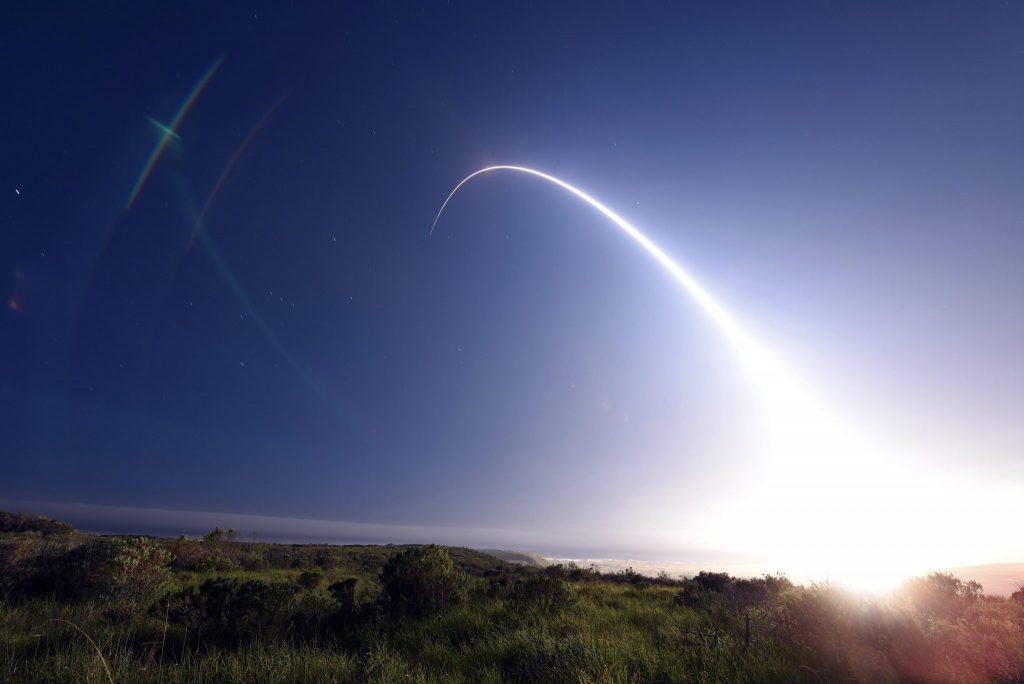Talking away from Armageddon
By Lawrence J. Korb, Arnold S. Kohen | August 27, 2019
 A test launch of an unarmed intercontinental ballistic missile, 2016. Credit: US DOD. The appearance of U.S. Department of Defense visual information does not imply or constitute DOD endorsement.
A test launch of an unarmed intercontinental ballistic missile, 2016. Credit: US DOD. The appearance of U.S. Department of Defense visual information does not imply or constitute DOD endorsement.
The collapse of the Intermediate-Range Nuclear Forces Treaty on August 2, the August 8 explosion in Russia stemming from the apparent testing of a new type of nuclear-powered cruise missile, and the flight testing of a ground-launched cruise missile off the coast of California on August 20 are only the latest manifestations that point to an accelerating nuclear and conventional arms race that, all told, could cost trillions of dollars over the next 30 years. With international agreements governing nuclear weapons under the gravest threat in decades, the imminent danger these weapons pose should receive the attention it deserves. This is especially true in light of new missiles under development that can travel at more than five times the speed of sound, space weapons, and largely undetectable cyber technologies. With a few wrong decisions, the world could be on the road to destruction within minutes.
A key enduring problem between the United States and Russia is that each has grave doubts about the intentions of the other side. To address these mutual suspicions and head off short-term dangers, a critically important first step would be to renew multilevel communications between the two countries. But such communications should not stop there; they should also aim to forge more long-term solutions that would both avert a potentially catastrophic confrontation and free up enormous resources to spend on more pressing issues.
Even in the darkest days of the Cold War between the United States and the Soviet Union, there were abundant communications, and these played a big role in keeping the peace. In far less dramatic circumstances now, there is no reason why the United States and Russia cannot engage intensively for the greater good.
However, the present state of affairs is alarming. As cogently outlined by Ernest Moniz and Sam Nunn in a recent article in Foreign Affairs, “The Return Of Doomsday,” communications between Russia and the United States are shockingly limited, with a real threat of accidental conflict based on miscalculation and misunderstanding—perhaps worse than any time since the Cuban Missile Crisis of 1962. Both sides must reinforce the telephone “hotline” established in 1963 and the risk reduction centers first opened in 1988. And there must be firm public insistence upon continuous communications among the United States, Russia, and other nuclear powers to head off possible military confrontation.
Both official and unofficial conversations are vital, and in time could lead to new understandings on both nuclear and conventional weapons. Creative plans must be made not only to save remaining agreements such as New START, but also to shape a new, more ambitious system. Future agreements, formal or informal, must take into account ballistic missile defense and newer developments such as hypersonic and space weapons. The testing of new weapons only underscores the need for thoroughgoing exchanges of how to avert military conflict.
On another level, other kinds of communication and deliberation are also necessary. For example, a quiet nongovernmental meeting in Rome in June underscored the need for continuing discussions involving Russian, American, and other expert practitioners together with religious leaders with a record of extensive historical cooperation. Such discussions may be an effective way to channel recommendations to governments to help address the nuclear crisis. Taken together, these could gradually set the stage for the reduction of nuclear arsenals to minimal levels on the road to disarmament as promised by Article VI of the Nuclear Non-Proliferation Treaty.
As Presidents Mikhail Gorbachev and Ronald Reagan, who signed the INF Treaty in 1987, said at the time, “A nuclear war cannot be won and must never be fought.” Pope Francis has affirmed that “spending on nuclear weapons squanders the wealth of nations. To prioritize such spending is a mistake and a misallocation of resources which would be far better invested in the areas of integral human development, education, health and the fight against extreme poverty.” Significantly, Russians highly experienced in nuclear weapons strategy have also stressed that nuclear arsenals should be reduced to avoid cuts to health and education in Russia itself.
Pursuing pathways aimed at achieving global security of this kind would provide positive incentives and outcomes for the parties involved and for people throughout the world, rather than doomsday scenarios that should have been left behind with the end of the Cold War. Military and political experts, economists, and those with links to top governmental circles should pursue innovative discussions. The energy and ingenuity devoted to developing new generations of nuclear arsenals as well as hypersonic and space weapons should be redirected into sustaining effective diplomatic and military-to-military communications that could make the world much safer, and ultimately help make more financial resources available for pressing human needs.
Together, we make the world safer.
The Bulletin elevates expert voices above the noise. But as an independent nonprofit organization, our operations depend on the support of readers like you. Help us continue to deliver quality journalism that holds leaders accountable. Your support of our work at any level is important. In return, we promise our coverage will be understandable, influential, vigilant, solution-oriented, and fair-minded. Together we can make a difference.
Topics: Nuclear Risk, Opinion















